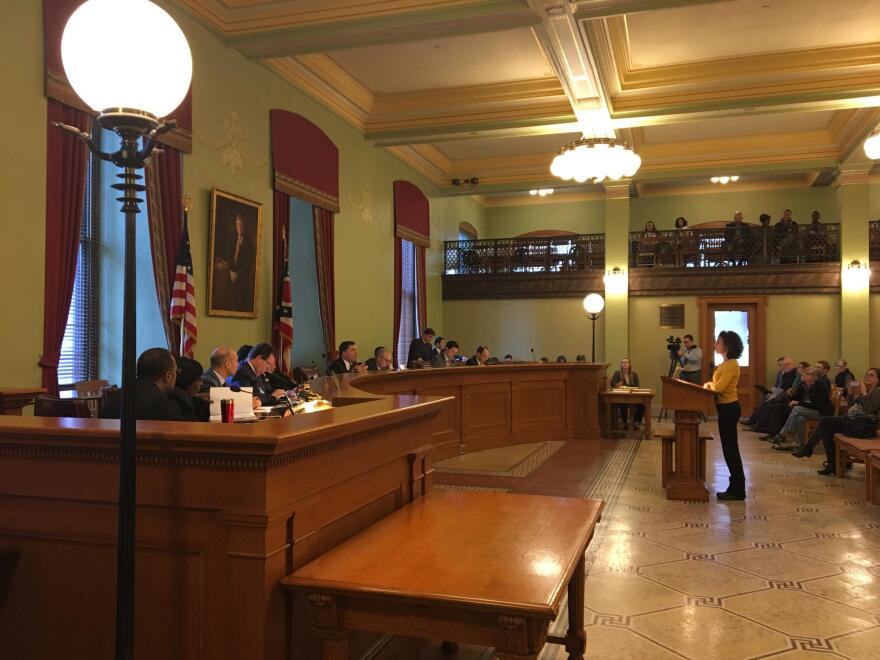It’s crunch time for Ohio lawmakers wrangling with Congressional redistricting reform.
Lawmakers must quickly consider whether to pass their new plan and put it before voters in May. It’s been revised to encourage Democrats to buy in, but those changes haven’t been enough for either them or for citizens’ groups that plan to put a different redistricting issue before voters this fall.
At times, the battle has gotten pretty heated. Because of the powerful effects of how Congressional district maps are drawn, the issue of redistricting has always been contentious at the Statehouse. Right now, state lawmakers draw that map, and the current one has been widely criticized as among the most gerrymandered in the country.
At a Senate Government Oversight and Reform meeting on Tuesday, the Republican-dominated committee listened as Mia Lewis, a citizen who has been working with progressive-leaning Fair Districts Fair Elections Coalition to put a redistricting issue on the fall ballot, explained her proposal.
“There are ways of drawing lines that bring us closer to representational fairness," Lewis says.
But her testimony got testy at times. Lewis was interrupted a few times by Republican state Sen. Bill Coley, the head of the committee.
“Let me ask you a question,” Coley asserted at one point. “You respond to my question. That’s the way the system works very well.”
And again, a little later: “May I answer?” Lewis asks. “No, you can’t right now,” Coley responds. “I’m going to stop you right there.”
Then, Democratic Sen. Joe Schiavoni stepped in.
“Mr. Chairman, can I make a point of order?” Schiavoni asks.
“No, no you can’t right now, but you can in a minute,” Coley says
A minute later, Schiavoni unleashed his frustration.
“You’re over here saying, ‘This is how this works, this is how this works,’ and you are yelling at the witness. And then you are laughing at the witness. This is not how this is supposed to work,” Schiavoni said to some audience applause, as Coley pounds his gavel. “And again, that is not how this is supposed to work. They’re allowed to clap if they like.”
“No, they are not,” Coley responds.
Schiavoni criticized the way Coley yelled at Lewis, calling his treatment “ridiculous.”
Lewis says it was her first time testifying in front of Coley and this panel.
“I was a little shaken up,” she says.
Later, after the committee recessed, Coley came back in the hearing room, sat down and talked to Lewis about the proposal.
The tension around this issue has been rising, and Sen. Matt Huffman, the sponsor of the redistricting plan being considered by the committee, says it’s because lawmakers know they need to do something with it now.
“Often times, people don’t make decisions until they have to,” Huffman says.
He says they have to right now. February 7 is the last day to put an issue on the May ballot, and this proposal must pass the House and Senate before then. And in Huffman’s mind, it’s May or never because he doesn’t see the lawmakers’ plan trying to compete with the citizens’ groups’ plan on the November ballot.
“I think it’s difficult for the public to digest," Huffman says.
Huffman says he wants a bipartisan agreement on one proposal. And while he says he made “significant changes” to the legislative proposal, to make it more palatable to Democrats and the citizens' group, it hasn’t been enough to convince them to get on board. But he says the two sides are continuing to talk.
Still, Catherine Turcer with Common Cause Ohio says the changes that have been made are cosmetic, and that there is a major sticking point that is non-negotiable as far as she’s concerned.
“His proposal does not have a rule prohibiting gerrymandering," Turcer argues.
And for Heather Taylor-Miesle of the Ohio Environmental Council, another group that’s pushing the citizen-led effort, there are two requirements that are deal-breakers: ending gerrymandering and keeping communities together in Congressional maps.
“That’s the deal we can cut. That is the deal we want,” Taylor-Miesle says. “That is the deal we will show up forever to get because we believe when voters are empowered, we can get the kind of representation we need.”
The Fair District groups say they already have two-thirds of the signatures needed to put the issue on the ballot in November – the same ballot on which voters will be deciding key state offices, including the governor. Redistricting could become the political football many candidates wish wasn’t part of the fall lineup.





